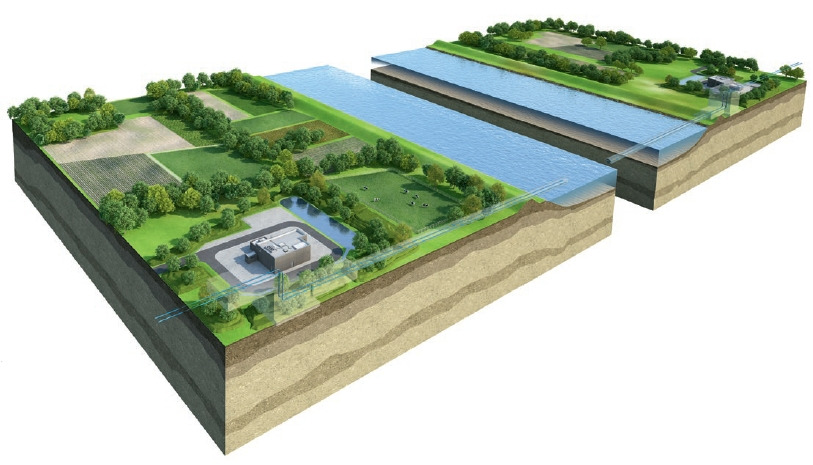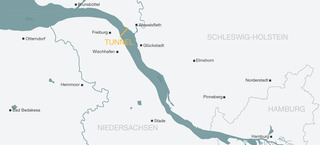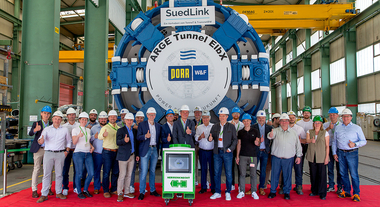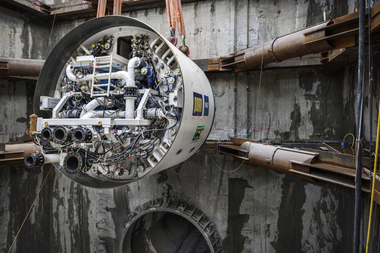Porr Wins Tunnel Construction Contract for Elbe Crossing of SuedLink Wind Power Line
The SuedLink project to construct a powerful direct current transmission line is vital to ensure a stable power supply in the future. It will transport renewable energy from wind farms in northern Germany to the south of the country and is a necessary step in the energy transition. The plans for the SuedLink project include a tunnel crossing under the Elbe River. TenneT TSO GmbH, a leading European transmission system operator, has engaged Porr’s tunnelling division for the challenging task of establishing the SuedLink connection under the Elbe between Schleswig-Holstein and Lower Saxony. The contract is worth more than 250 million euros.
 The European grid operator TenneT TSO GmbH awarded Porr Tunnelbau the contract for the SuedLink Elbe crossing between Schleswig-Holstein and Lower Saxony. The contract is worth more than 250 million euros
The European grid operator TenneT TSO GmbH awarded Porr Tunnelbau the contract for the SuedLink Elbe crossing between Schleswig-Holstein and Lower Saxony. The contract is worth more than 250 million euros
Credit/Quelle: TenneT TSO GmbH
“The SuedLink project is crucial for securing the power supply in Germany and we are proud to be contributing to this project. Drawing on our many years’ experience in tunnelling, Porr will play its part in completing the Elbe crossing on schedule,” said Karl-Heinz Strauss, CEO of Porr AG. Germany has set an ambitious goal of sourcing at least 80% of its power from renewable energy sources by 2050.
 Karl-Heinz Strauss, CEO Porr AG
Karl-Heinz Strauss, CEO Porr AG
Credit/Quelle: Astrid Knie
This presents a challenge for the electrical grid, which must be adapted to the modified generation structure to ensure a stable power supply in the future. The SuedLink project aims to transport primarily wind generated power from northern to southern Germany. Two underground high-voltage direct current (HVDC) transmission cables will be able to transmit up to 4 GW across Germany.
However, renewable energies are not only generated from local sources all over Germany – they also exhibit strong fluctuations in their infeed levels. The direct current technology in the SuedLink project makes it possible to react to such fluctuations with greater flexibility and to control load flows more effectively. The cables’ transmission power is roughly equivalent to the output of four nuclear power stations and could supply power to around ten million households.
A Tunnel 20 Metres Below the Elbe River
Construction of the connecting tunnel crossing below the Elbe is scheduled to begin in the autumn of 2023, subject to planning permission. The work will commence with construction of a shaft in Wewelsfleth, Schleswig-Holstein. From there, the 5.2 km tunnel will run approximately 20 m below the Elbe until it reaches its destination: the target shaft at Wischhafen, Lower Saxony.
 SuedLink Elbe crossing: The work will commence with construction of a shaft in Wewelsfleth, Schleswig-Holstein. From there, the 5.2 km tunnel will run approximately 20 m below the Elbe until it reaches its destination: the target shaft at Wischhafen, Lower Saxony
SuedLink Elbe crossing: The work will commence with construction of a shaft in Wewelsfleth, Schleswig-Holstein. From there, the 5.2 km tunnel will run approximately 20 m below the Elbe until it reaches its destination: the target shaft at Wischhafen, Lower Saxony
Credit/Quelle: TenneT TSO GmbH
As the two shafts are at groundwater level, the construction pits for the shafts will have to be made waterproof with up to 50 m deep diaphragm walls prior to excavation – a challenging proposition.
The 25 m deep construction pits will then be excavated underwater, drained and secured with steel girders. At that point, the tunnel-boring machine manufactured specifically for this project will be assembled. It is designed to cope with the varying soil properties below the Elbe. The tunnel will be constructed with an inner lining of concrete segments. The access infrastructure required for subsequent use will be built in Schleswig-Holstein and Lower Saxony during the tunnel boring phase. Completion of the tunnel is scheduled for 2027.



